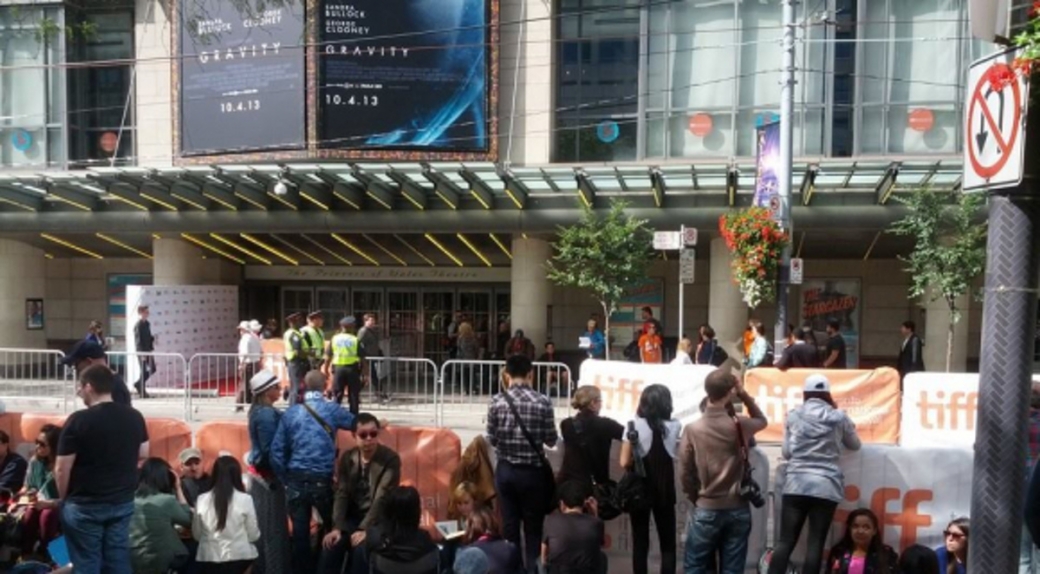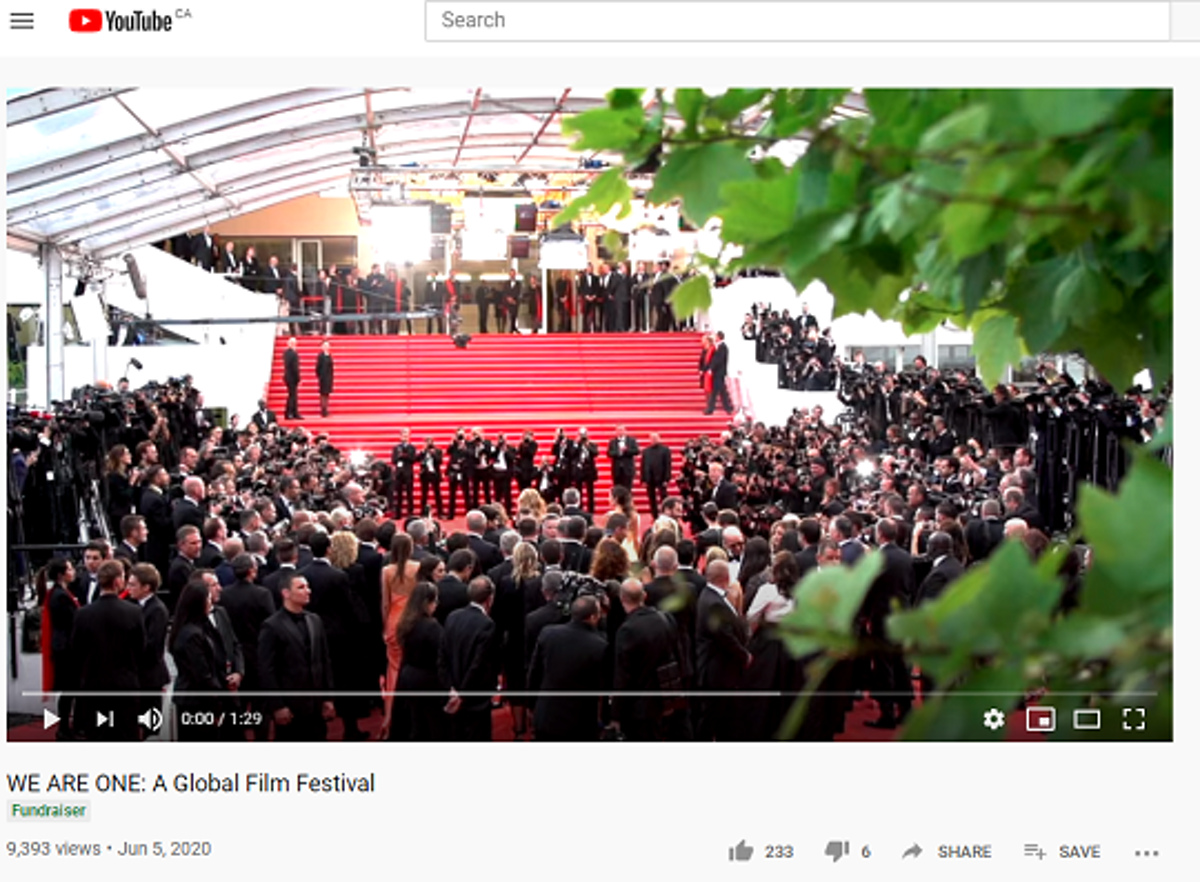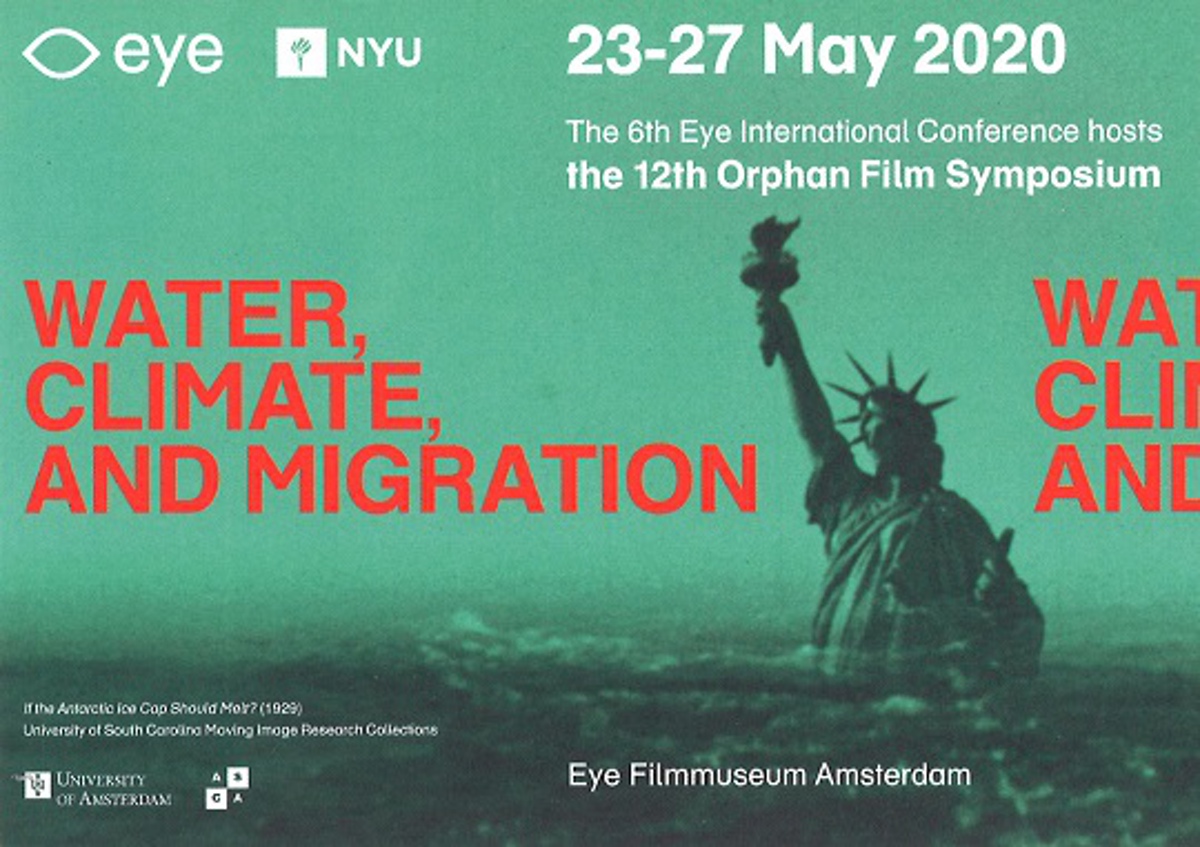
Fans awaiting arrival of celebrities at TIFF 2014, photo by Ger Zielinski, Creative Commons Attribution CC BY-NC licence.
In-Sync or Not
Reflections on the Proliferation of Online Film Festivals during the COVID-19 Global Pandemic
In this text I present a series of reflections on how selected film festivals are responding in their own ways to the coronavirus pandemic and on their potential as open access sites of cinephilic adventure and altered festival-going experience. As a survey, it is necessarily incomplete but will surely be filled in later as scholars continue to conduct their systematic research. As the first major wave of the COVID-19 finally arrived in North America in March 2020, my thoughts eventually turned to the near future of film festivals, those special ‹agoras› and gathering places for fans and industry professionals alike. While the first festival cancellations were announced in early March, Montreal’s longstanding International Festival of Films on Art (FIFA) was the first to my knowledge at the time to announce its intention to provide an online edition. The festival was only a few weeks away from its start date, so it acted very swiftly and impressively in creating the necessary infrastructure for streaming. As a high-tech hub for the likes of Softimage and many other start-ups, it seemed appropriate that such an ambitious attempt to bring the festival online would be taken in that city. A very different beast, the A-list Cannes International Film Festival announced in mid-April that it was researching alternative formats but was eventually cancelled in June. Nevertheless, the festival released its list of films in competition which sets the bar annually for other international film festivals around the world. The stakes were different for any two festivals of whatever types, and their responses to the COVID-19 situation were telling. I aim to give below some historical context to the problem of contagion at mass gatherings and gesture to what other media scholars have been writing about the pandemic, while presenting and analyzing how the selected film festivals have been adapting themselves to the situation, often building on an open access ethos, and their social consequences, such as layoffs and environmental concerns over streaming infrastructure.
Festivals and mass gatherings of all sorts have long been and continue to be sites of transmission of disease. Evidently, film festivals present similar problems for their densely populated indoor activities, such as queuing for tickets and screenings, meetings, waiting between events, socializing, and the screenings themselves. However, the special character of COVID-19 and its transmission rendered any such gatherings highly dangerous to participants and their social circles. Not surprisingly but with great disappointment, film festivals around the world announced their cancellation, online, or hybrid online/offline versions, as the gravity of the pandemic became known. Let us now consider how selected film festivals have been adapting themselves towards and away from open access principles and the possible long-term changes that the crisis might pose to festivals.
The COVID crisis has provoked scholars in a variety of disciplines to consider how we are responding to the situation. Archivists are keen to collect personal stories in the form of online diaries while the activity of writing out one’s experiences reduces stress. One instance is the open access online English-language Journal of The Plague Year: A COVID-19 Archive. In April, media scholars Patricia Zimmermann and Caren Kaplan began a conversation on the characteristics of a possible emergent genre centred on drone footage during the crisis and the production of spectacles of distance and melancholia. As a part of his continuing research project on the urban night, Will Straw addresses the question, «How has COVID inflected the aesthetics, politics, and social dimensions of the urban night?», among a collection of papers dedicated to different aspects of our changed night cultures in the same journal. Film festivals intersect these areas as sites where such material might be organized into programs and screened or, as in the third case, many festivals contribute to (day and) night culture through not only their screenings but also their events and activities. While it will require much more research to confirm the details, it seems reasonable to assume that networking among fans has gone online to various platforms, both private groups, e.g., on Facebook, or public gossip via Twitter, among many others. During COVID-19 it is reasonable to assume that no one, no critic, no fan, no director, no actor, et al., will serendipitously cross paths with one another by chance in a bar or restaurant near the festivals site. As for the exclusive parties, I must leave that to other researchers to speculate on. There have never been more live-streamed free-of-charge interviews with film celebrities over Facebook and Instagram, which the organizers anticipate will find their respective fan groups and increased fan engagement with the online festival. From a researcher’s point of view these new heightened online activities pose significant challenges to method, particularly regarding learning more about the largely anonymous and unreachable audience, depth of engagement, among other data. On the one hand, while it might produce a more open festival by lowering the exclusivity of access to such celebrities, it will likely be used in the future as a form of attention-grabbing publicity. I wonder how the young filmmaker now makes a splash and pitch where there no place to do so; will the virtual industry sessions suffice in replacing the physical event of the festival? Again, I must defer to future researchers.
The proposition that «a film festival exceeds the simple sum of its films» is certainly being reconfirmed throughout the crisis, as many festivals go virtual. Consider the pass attached to one’s dangling lanyard sports ‹industry,› ‹press,› ‹public,› or something else; in many respects at least influence if not determine how the festival-goer experiences the festival, range of social encounters, networking opportunities, access to various industry players, and so forth. Fans and critics respond to the audience’s reactions in their own ways. If festivality1 includes the structure, ethos, and qualitative experiences of a festival, comparing the physical space of conventional festivals and the current virtual online adapted festivals would bring out important contrasts. The little things matter in one’s experience of a festival. What the festival-goer remembers are the short conversations with critics or journalists in the cinema or in queue for a drink, the sighting of a cherished celebrity or director, the tip from a volunteer, the demanding punctual schedule set by the choice of screenings, the audible reaction to a film at a screening, and so forth. All these contingent encounters are radically displaced by the exclusively online experience. If one is not privy to the right online social media group and discussion, if it exists at all, the gossip will be missed.
Since March 2020 there has been an intensification of experimentation with the online streaming delivery of festival films, while till now festivals and streaming have been at best awkward bedfellows. Even though YouTube was founded in 2005 out of a radical open access ethos common to the early internet and subsequently purchased and monetized by Google, it remains an important virtual site for viewing individually (asynchronously, alone) and exchanging comments on a very wide range of videos, along with many other newer commercial streaming services. Film festivals as a form emerged from a long history of more general festivals extending back to the earliest human rituals and gatherings in person (synchronously, together). Moreover, contemporary film festivals are tightly integrated into their respective host cities’ tourism campaigns and economies, with a mixture of private and public funding, depending significantly on what country and region. In short, the local festival is designed in part to bring people to the city. Festivals might have used streaming for selected industry workshops or question-and-answer periods/interviews with actors or directors, perhaps a section of non-competition short films, but very rarely have they employed live-streamed (synchronous) or block-timed (asynchronous) feature films to be watched at home. My closest experience to this was when I served on selection committees or awards juries and had to watch dozens of films in advance either at home or in my hotel room while the festival continued. The fomo (fear of missing out) was strong. With COVID-era festivals, when we ‹attend› an online festival, we encounter similar experiences without the fomo since there is no gatherings or activities to be missed; instead we watch alone from home on our best digital device. Social media picks up some of the slack on the fan gossip front, as we exchange messages about whatever we see. The seasoned festival-goer surely notes not only the strangeness of ‹attending› from one’s domestic space and loss of the festival bubble that brief inoculation from everyday life, but also the technical bandwidth and streaming problems arising at either end of the steam.
Festivals of all sorts, but certainly not all festivals, have had community-responsive ticket and pass pricing in order to allow an enlarged swath of public access. These initiatives often include a free set of tickets or a pass for volunteers, and reduced priced or free tickets to the unemployed or underemployed. Some of this ethos has carried over into the largely improvised experiments in the online versions. Instead of taking the past year of planning as an utter loss and not proceeding with any festival at all, many have chosen to offer at least a selection of films, if not all the programs, for free, open to anyone with a digital device with an adequate processor and sufficient broadband access. Very likely, unemployed or underemployed people would likely not own a computer with a processor fast enough to access the videos streaming online or could afford adequate bandwidth for the streaming itself. Evidently, this techno-economic barrier did not occur in conventional festivals, where interested festivalgoers would present themselves in person, but how could this be measured in any sense? Going online certainly opens up the extent and reach of a festival, but it eliminates those who are below the techno-economic threshold. This may be a blind spot for those who put too much emphasis on the emancipatory potential of the technology and its infrastructure for open access. As noted above, most festivals have some obligation through funding and mandates to their host city to train and employ people and contribute to the local culture.

Wikimedia Foundation Servers, photo by Victor Grigas, Creative Commons Attribution CC BY-SA 3.0 license
Before COVID-19 our total internet activities consumed as much energy as the entire airline industry, namely about 2% of all energy consumption worldwide. Of course, with the arrival of the pandemic the airline industry is facing its own severe financial crisis, and we are all keeping distracted by streaming our favourite series and films online at home, so I must presume that our internet activities have overtaken the airline industry and that the estimate of 2% will change. One innovative festival to emerge during the pandemic is the Small File Film Festival, based at Simon Fraser University in Vancouver. Its aim is to bring to light the fact that «streaming media has a massive carbon footprint.» The internet may appear ethereal and even magical to most of us, but its use relies on the very real highly-energy-consumptive infrastructure of servers that holds our digital files and permits them to be accessible at any time. Media scholar (and co-organizer of this festival) Laura Marks addresses such issues in her recent article on the various costs and consequences of online streaming. The festival could be seen, arguably, as continuing the tradition of low-fi (low-fidelity) or small gauge media, where the ‹small file› critically challenges professional formats and standards. Not surprisingly, many of the films were short in duration and of an experimental nature that tested out formal qualities enabled by the small-file constraints of the medium. Again, the open access movement should integrate a more comprehensive approach to openness that includes an environmentalist dimension and consider the sources of the energy supplying the servers. The internet has become a rich resource with great potential, but its infrastructure is not magical and without material consequence.

We Are One: A Global Film Festival (2020), screen capture of festival’s YouTube channel, fair use.
While festivals of all types collaborate with one another formally or informally, one of the most curious and unexpected collaborative festivals to emerge has been the ten-day online We Are One: A Global Film Festival organized by the COVID-19 Solidarity Response Fund (aka YouTube and Tribeca Enterprises) as a fundraiser for the World Health Organization. Uniting major international film festivals based in Annecy, Berlin, Cannes, Guadalajara, Macao, Jerusalem, Mumbai, Karlovy Vary, Locarno, London, Marrakech, New York, San Sebastian, Sarajevo, Sundance, Sydney, Tokyo, Toronto, Tribeca, and Venice, it raised a modest $22,441. One film was programmed by each of the twenty-one participating festivals as well as a series of YouTube-native channels to be screened for free either live-streamed or on-demand on YouTube over the festival’s ten days. As a fundraiser it clearly underperformed. Was it simply a trial run by YouTube for something else to come? I will have to leave speculation over this initiative to other researchers looking into it in detail.
One of the first online festivals that I attended was in March. The 58th Ann Arbor Film Festival (AAFF) made a valiant effort to present programs and interviews as a free live-streamed six-day event via Vimeo. I had only read about this famous experimental film festival but had never made the trip. However, the challenge of synchronous streaming is that the festivalgoer has to be synced punctually with the festival’s time zone, and if the streaming is disrupted, the event or screening is compromised. Naturally, given the heightened improvisation at this and other festivals, there were technological problems with the streaming. Indeed, perhaps if it had operated with a much greater budget, it could have been prepared to meet the challenges quickly, but that is merely a pipe dream for most festivals. This is another instance of the techno-economic glass wall and is implicitly a part of any online festival. Similarly, a streaming problem could also happen at the home of the festivalgoer, as the signal fluctuates. Other festivals tested out alternatives to live streaming by providing recorded versions with access over a fixed period.

Orphans 2020: Water, Climate, and Migration, Orphan Film Symposium poster, fair use.
This May’s Orphan Film Symposium, a hybrid of academic conference and film festival, was dedicated to timely themes: Orphans 2020: Water, Climate, & Migration, originally planned as an in-person event at the Eye Filmmuseum in Amsterdam but turned online and based at NYU Cinema Studies’ Vimeo account. The symposium and screenings are all still available via the linked in the online program. The notion of the orphan film carries the sense of films that once had a specific purpose but had then, like ephemera, been superseded. Film historian Gregory Lukow sketches out the relationship between orphan films and archives in a paper from 1999, «In the early 1990s concept of the orphan film emerged as the dominant metaphor within the moving image archival community for use in positioning film preservation as a legitimate enterprise on the national public policy cultural agenda.»
Moreover, the pandemic has thoroughly compromised the livelihoods of professional performers, including musicians, actors, and dancers. The Shut In Dance Fest, an online festival that aims to help motivate dancers stuck in quarantine, popped up this spring. However, performers were certainly not the only cultural workers affected by COVID. Labour issues surrounding festivals often receive scant attention. Festivals that rely on the sale of tickets and passes were doubtless hit by their cancellation or move online. Management at the Toronto International Film Festival (TIFF), for instance, furloughed 17% of its full-time staff in anticipation of 50% reduction in revenue, and similarly for Film at Lincoln Center where 50% of its staff was laid off and Sundance where 13% of the staff was let go, among others. This fact will be conveniently unknown to most attending online festivals, and, at least in the context of our current crisis, it will remain one of the costs and consequences of eliminating the physical sites of festivals and replacing them exclusively with online streaming.2 Festival work has been known for its precarity and seasonal nature; during the pandemic its precarity has expanded to include not only part-time seasonal workers but also fulltime staff. These issues will have to be addressed seriously if enthusiasm grows for a higher integration of online streaming at future film festivals.
The COVID-19 crisis has certainly made a significant impact on film festivals and those who rely on them for their livelihoods, as also stated by Julian Hanich in his recent post on this blog. While some festivals were cancelled, others adapted themselves to online streaming schemes, and even new ones were founded in order to address the unique context of the crisis. However, no change should be reduced to a simple technological framework; our choices in technology, here online streaming, have important consequences in relation to the environment and energy consumption, who may attend the festival virtually, but also festival workers and the restructuring of the festival workplace. Doubtless the experimentation with online streaming during the crisis has been unprecedented in the history of film festivals; its future use will require careful negotiation in relation to the issues mentioned above. The film festival researcher will have to develop a new set of methodologies to meet the task at hand, somehow. Depending on the emphasis and research questions, how will the online audience ever be known adequately, and even simple statistics on the number of viewers of individual films are vague at best. If the COVID-19 crisis is permanent or if festivals take the leap and remain significantly online, quantitative approaches to the study of film festivals will certainly face immense challenges and further limits on the questions the research may ask. As noted above, it will be important to remember what is elided in this potential transition to greater streaming on the part of festivals. While this brave new world opens up fascinating opportunities for broader outreach, it also brings with it an invisible techno-economic glass wall.
- 1For more on the concept of festivality, see my chapter “On Studying Film Festival Ephemera: The Case of Queer Film Festivals and Archives of Feelings” in Film Festivals: History, Theory, Method, Practice, eds. Marijke de Valck, Brendan Kredell, and Skadi Loist. Routledge (2016), 138-158.
- 2For an early piece on labour and film festivals, see Skadi Loist’s “Precarious cultural work: about the organization of (queer) film festivals,” Screen, Volume 52, Issue 2, Summer 2011, 268–273.
Bevorzugte Zitationsweise
Die Open-Access-Veröffentlichung erfolgt unter der Creative Commons-Lizenz CC BY-SA 4.0 DE.